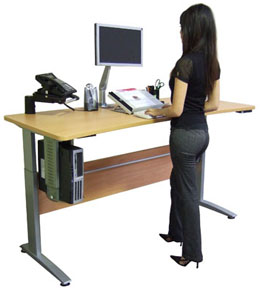By Dr. Jennifer Klau
In lieu of offering you suggestions for the hour or so your students are with you on a given day, here’s what we all should be doing for the better part of the other 23 hours: standing up. Get out of that chair, spend less time in it, and you will reduce your overall risk of dying and disease. Of all of the things we do to improve our health and minimize disease risk, this has to be the simplest one yet. Spend less time sitting. That includes computer time, movies, TV, driving, eating, sleeping, reading. The data are in and they are resolute: the more time we spend immobile, the greater our risk of all-cause mortality, independent of physical activity. You read that right—even if you work out, a lot, all the other sedentary hours still count against your health. (1-3) Yikes!
 The good news, though, is that there are a number of simple steps you can take to reduce the amount of time spent sitting. For example, I write this at my standing desk. You can find many different models online, from expensive ones that move at the touch of a button to salvage-chic or DIY. Mine is a combination of some Ikea desk components, an articulated arm for my computer, and a moveable keyboard tray. I started standing after going a few nasty rounds with sciatica (sciatic nerve 2, JFK 0), but I’ve stayed standing after reading the papers cited here and others. The beauty of having a desk that moves (or components that do, as in my case) means that I spend most of my time standing, but I have the option of sitting. As with most things, you don’t have to quit sitting cold turkey, but you should be looking for all kinds of ways to increase time on your feet instead of your bottom. (4)
The good news, though, is that there are a number of simple steps you can take to reduce the amount of time spent sitting. For example, I write this at my standing desk. You can find many different models online, from expensive ones that move at the touch of a button to salvage-chic or DIY. Mine is a combination of some Ikea desk components, an articulated arm for my computer, and a moveable keyboard tray. I started standing after going a few nasty rounds with sciatica (sciatic nerve 2, JFK 0), but I’ve stayed standing after reading the papers cited here and others. The beauty of having a desk that moves (or components that do, as in my case) means that I spend most of my time standing, but I have the option of sitting. As with most things, you don’t have to quit sitting cold turkey, but you should be looking for all kinds of ways to increase time on your feet instead of your bottom. (4)
Standing makes use of our lower-body and postural muscles that support our weight and keep us upright, and using muscles means using calories. Admittedly, not a ton, but they all count in the overall battle to stave off creeping pounds and disease risk. I’ve found that I fidget and move around a lot more while standing at work. Like any modifiable risk, resisting the siren call of the seat has its limitations. Driving is a seated affair, as is dining in polite society (as it should be, but that’s a separate debate) and most meetings. If you decide to stand next time you go to a movie, please stand in the back, and no, this isn’t an excuse to grab greasy take-out from the place that has nowhere to sit down.
Standing has benefits beyond the metabolic—the slower blood flow and other circulatory aspects of being seated may increase blood vessel damage (worse still if one is otherwise physically inactive). (5, 6)
Please note, by the way, that sitting versus standing discussed here has nothing to do with position on the bike. This is all about the other 22 or 23 hours of the day, because even working out 4 hours a day won’t make up for 20 hours in a heap.
Many of our students also want to know how often they should exercise. “As often as you can” isn’t a very helpful response (even if it’s true), but it never hurts to remind people that some is better than none, and what they do off the bike counts, too.
Encourage your students to find creative ways to increase activity in their lives, and make sure you’re doing it, too. Modern life is not a bad thing; we benefit from all kinds of technological and medical marvels, not to mention a physical ease for tasks of daily living unparalleled in human history. But, with the wonders come the risks. As instructors we can be conduits of important information for our students, and we can help them find fitness on and off the bike. And whatever you do, don’t just sit there!
1. Friedenreich CM, Neilson HK, Lynch BM. State of the epidemiological evidence on physical activity and cancer prevention. European Journal of Cancer 46: 2593–2604, 2010.
2. Koster A, Caserotti P, Patel KV, Matthews CE, Berrigan D, Van Domelen DR, Brychta RJ, Chen KY, Harris TB. Association of sedentary time with mortality independent of moderate to vigorous physical activity. PLoS ONE 7: e37696, 2012.
3. Owen N, Healy GN, Matthews CE, Dunstan DW. Too much sitting: the population health science of sedentary behavior. Exerc Sport Sci Rev 38: 105–113, 2010.
4. Rutten GM, Savelberg HH, Biddle SJH, Kremers SPJ. Interrupting long periods of sitting: good STUFF. Int J Behav Nutr Phys Act 10: 1, 2013.
5. Thijssen DHJ, Green DJ, Hopman MTE. Blood vessel remodeling and physical inactivity in humans. Journal of Applied Physiology 111: 1836–1845, 2011.
6. Thijssen DHJ, Maiorana AJ, O’Driscoll G, Cable NT, Hopman MTE, Green DJ. Impact of inactivity and exercise on the vasculature in humans. European Journal of Applied Physiology 108: 845–875, 2010.


Thank you Jennifer. For my personal training clients, I used to talk about cardio, strength and nutrition as the measurables. Lately, I’ve been adding the idea of daily steps. I’m encouraging use of the “Fit Bit” as a neat little pedometer.
I always appreciate the conversational way you present material.
Renee, the show looks interesting. In the lab where I did my graduate work there were some studies looking at how people with certain SNPs (single-nucleotide polymorphisms, or variation at the level of one of the letters in a gene sequence) responded to different exercise intensities. The idea was to find the minimum effective dose for particular variations.
It’s not cheap to sequence, so it’s not coming to a gym near you anytime soon, but it IS fascinating, and definitely shows that one size does not fit all. There are even some poor souls who can do 8 – 12 weeks of exercise designed to increase VO2max (in a controlled environment, so we know they did the work at the assigned intensity) and have no response. Zero. Bummer for them, but intriguing for scientists. Last I read, the response/lack of was due to the interaction of hundreds of genes, none of which was directly responsible for any of the changes we associate with exercise. The mystery deepens.
In the meantime, the more we *don’t* sit around waiting for definitive answers, the better. 🙂
Thanks Jennifer. Here’s some more information that speaks to what you just wrote about.
I just watched a show last night (previously aired & taped) on PBS titled The Truth about Exercise with Brian Mosley. I highly recommend watching this, very informative. Very much on point about the problem of sitting too much, individualized aerobic training necessity and why, and some very interesting information about HIT and the amount that a person needs to get the benefits.
http://video.pbs.org/video/2364990532/
It just so happened that this “individualized” program was exactly what i had spoken to my power cycling class on Monday stressing the benefits and importance of knowing and working with their own threshold and power zones numbers. I used the analogy of visting our physicians and wanting to be treated individually not as an average or like the AVERAGE guy/girl that walked out before us. we pay more and we want more.
I’ve been sitting for weeks now…Need to get up!
We can send a crane if need be. 😉